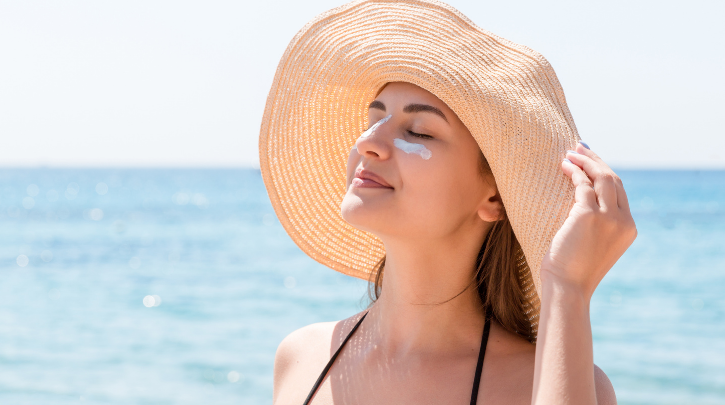
- United States
Get non-surgical solutions for today's top aesthetic concerns with Venus Treatments. Join thousands of satisfied patients worldwide!
- Loading...
- All Regions
Get non-surgical solutions for today's top aesthetic concerns with Venus Treatments. Join thousands of satisfied patients worldwide!

Taking care of your skin isn’t just important when it comes to beauty—it’s fundamental. Good skin care goes beyond beauty, as it’s essential to your health as well. This summer, protect yourself from the number one enemy in your skin care journey: sun damage. Overexposure to the sun can result in a multitude of unwanted skin issues, like premature aging, sun spots, and wrinkles. Worst of all, it increases your risk of certain kinds of cancers. It’s never too late to start protecting your skin from the sun and treating it for signs of sun damage. Read on to learn how.
Exposure to the sun’s UVA and UVB rays is responsible for 90% of the visible changes you see in your skin as you age. Sunspots, wrinkles, fine lines, skin laxity, dry skin, and melasma are all signs of sun damage. Almost everyone will experience some form of sun damage on the face, neck, or body in their lives. Chronic overexposure, however, puts you at risk not only of aging faster and damaging the health of your skin, but also of developing skin cancer. That’s why it’s important to prevent and treat the signs of sun damage early if you want to maintain the youthful, healthy look of your skin as you age.
Protecting your skin from the sun is relatively easy—the most important thing is to do it regularly, and consistently:
Sunscreen that contains an SPF of 30 or higher is the best way to protect your skin from the signs of sun damage—and other risks as well. Exposure to UVA and UVB rays come with the risk of skin cancers and skin precancers. However, regular daily use of SPF 15 sunscreen can reduce your risk of developing squamous cell carcinoma by about 40 percent, and lower your melanoma risk by 50 percent. For that reason alone, you should strive to wear sunscreen every day. These days, there are several types of sunscreen products available, and it might take some trial and error before you find one that works for your skin type. Here are three things to look for:
Broad-spectrum coverage: Look for a sunscreen that protects from both UVB, the rays that cause sunburn, and UVA, the rays that cause tanning and premature aging. Now that UVA dangers are well known, broad-spectrum sunscreen provides clear information on product labels about protection against both UVB and UVA.
Type of protection: There are two main types of sunscreen protection, physical and chemical. Physical sunscreens most commonly contain titanium dioxide and zinc oxide, creating a physical barrier that reflects dangerous UV rays. Chemical sunscreens contain chemicals that protect the skin by interacting with and absorbing ultraviolet energy. Both are effective, but depending on your skin type, one may work better for you.
Water-resistant: These are best for activities like swimming or intense exercise. Sunscreens labeled water-resistant are effective at protecting your skin for up to two hours, even if you’re swimming or sweating.
Photofacials are a gentle but effective way to safely treat all of the signs of sun damage in one comprehensive treatment. Photofacials use Intense Pulsed Light (IPL) technology, which penetrates deep into the skin’s layers to resolve fine lines, wrinkles, sun spots, broken capillaries, rosacea, discoloration, and skin laxity. Because it is a non-surgical treatment, you don’t have to worry about unsightly peeling or a prolonged recovery time after a photofacial—in fact, the procedure requires no downtime at all. Photofacials also stimulate the natural production of collagen and elastin, the two elements responsible for keeping skin looking firm, youthful, and refreshed. The technology is safe for all skin types, and all areas of the body, too, including the neck and chest area, which tend to be prone to sun damage.
To find a clinic offering Venus Concept’s advanced photofacial treatments near you, simply use the search field below.
Find a certified Venus Treatments provider near you today who specializes in today’s top aesthetic medical solutions.



Search below to find a provider near you and to learn about our non-surgical aesthetic treatments with ARTAS®, NeoGraft®, Venus Bliss™, Venus Bliss MAX™, Venus Versa™, Venus Legacy™, Venus Velocity™, Venus Viva™ MD, and Venus Glow™.
For more information call: (888) 907-0115 // [email protected] // 1880 N Commerce Parkway, Suite 2, Weston, FL, 33326 United States
REGULATORY CLEARANCES [ More ]
Venus Bliss™ is cleared by the FDA for non-invasive lipolysis of the abdomen and flanks in individuals with a Body Mass Index (BMI) of 30 or less, with the diode laser applicators. The (MP)2 applicator is cleared by the FDA for temporary reduction in the appearance of cellulite.
Venus Versa™ is cleared by the FDA as a multi-application device intended to be used in aesthetic and cosmetic procedures. The SR515 and SR580 applicators are cleared by the FDA for the treatment of benign pigmented epidermal and cutaneous lesions and treatment of benign cutaneous vascular lesions. The HR650/HR650XL and HR690/HR690XL applicators are cleared by the FDA, for the removal of unwanted hair and to effect stable long-term or permanent hair reduction for Fitzpatrick skin types I-IV. The AC Dual applicator is cleared by the FDA for the treatment of acne vulgaris. The DiamondPolar™ and OctiPolar™ applicators on the Venus Versa™ system are cleared by the FDA for non-invasive treatment of moderate to severe facial wrinkles and rhytides on females with Fitzpatrick skin types I-IV. The NanoFractional RF™ applicator is cleared by the FDA for dermatological procedures requiring ablation and resurfacing of the skin.
NeoGraft® is cleared by the FDA with indication for use in suction-assisted follicular extraction and re-implantation. NeoGraft® is an auto-graft system and can be used on both male and female patients.
ARTAS iX™ is cleared by the FDA with indication for use for harvesting hair follicles from the scalp in men diagnosed with androgenic alopecia (male pattern hair loss) who have black or brown straight hair. ARTAS iX™ is intended to assist physicians in identifying and extracting hair follicular units from the scalp during hair transplantation; creating recipient sites; and implanting harvested hair follicles.
Venus Legacy™ is cleared by the FDA for the non-invasive treatment of moderate to severe facial wrinkles and rhytides in females with Fitzpatrick Skin Types I-IV with the OctiPolar™ and DiamondPolar™ applicators, and temporary reduction in the appearance of cellulite with the 4D Body (LB2) and 4D Face (LF2) applicators.
Venus Velocity™ is cleared by the FDA for hair removal, permanent hair reduction (defined as the long-term stable reduction in the number of hairs re-growing when measured at 6, 9 and 12 months after the completion of a treatment regimen), and the treatment of pseudofolliculitis barbae for all Fitzpatrick skin types.
Venus Viva™ is cleared by the FDA for dermatological procedures requiring ablation and resurfacing of the skin. The DiamondPolar™ applicator is cleared by the FDA for the treatment of moderate to severe wrinkles and rhytides in Fitzpatrick skin types I-IV.
Venus Freeze Plus™ is cleared by the FDA for the non-invasive treatment of moderate to severe facial wrinkles and rhytides in Females with Fitzpatrick skin types I-IV.
Venus Heal™ is cleared by the FDA for the relief of minor muscle aches and pain, relief of muscle spasm, and temporary improvement of local blood circulation. These indications enable the treatment of certain soft tissue injuries and conditions.
Venus Freeze™ is cleared by the FDA for the non-invasive treatment of moderate to severe facial wrinkles and rhytides in Females with Fitzpatrick skin types I-IV.
Venus Glow™ is cleared by the FDA as a Class I motorized dermabrasion device. It provides a dermal rejuvenation treatment that works to open up and deep-clean pores. Venus Concept is the exclusive distributor for Venus Glow™.
Venus Swan™ is cleared by the FDA for the non-invasive treatment of moderate to severe facial wrinkles and rhytides.
Copyright © 2024 Venus Concept. All rights reserved.
You are entering our website. For other countries/regions and language options, please click the SELECT A DIFFERENT REGION button below.
SELECT A DIFFERENT REGIONAre you looking to get a treatment? Please visit our patient website to learn more.
Click HereUnsure which aesthetic treatment is right for you? Take this quick and easy quiz to discover treatments that suit your needs.
Get Started